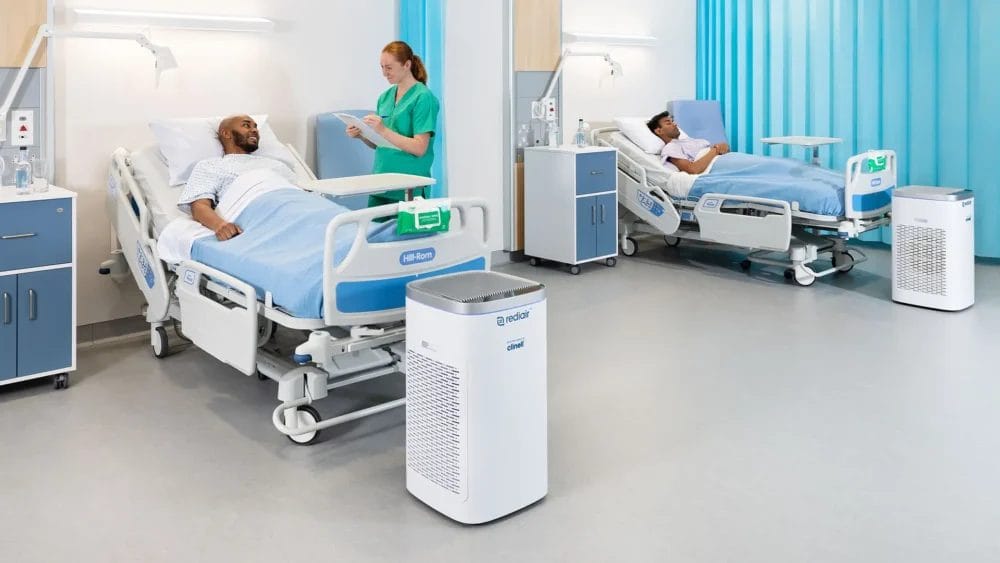Posted
7th July 2023
Research
A comparative evaluation of three different stand-alone HEPA-based air systems has been published in Infection, Disease & Health. The study used a range of measures to put the systems through their paces, concluding that the systems met their technical specification when tested in a healthcare environment, that noise could be an issue (with some units more than others), and that stand-alone air systems offer the potential to reduce the risk of spreading healthcare-associated pathogens via the air in healthcare facilities.

If you go to any Infection Prevention and Control conference these days, you will see a whole range of air systems. As our understanding of the role of air in the transmission of pathogens that can cause healthcare-associated infection (HCAI) has deepened, not least in the transmission of SARS-CoV-2 in a COVID-19 context, we have been confronted by the need to improve air quality in hospitals. There is no doubt that properly designed, built, and maintained mechanical air handling systems provide the optimal air quality in our healthcare facilities, many of the buildings in which we deliver healthcare are old and it’s simply not possible to have these systems everywhere. Therefore, there’s a role for stand-alone air systems to mitigate risk where we know that ventilation is poor.
This study took three stand-alone HEPA-based air systems and tested them in terms of airflow, noise, particle count, and smoke removal. The units were tested in a hospital single room, with an en suite bathroom. All three units closely matched their manufacturer technical specification in terms of measuring airflow and noise levels. However, when run at the highest setting, the noise levels were higher than would be permitted according to standards in a healthcare setting. Exactly what this means for patients and staff working around these units isn’t clear – but early evidence from healthcare settings where units have been implemented suggest that the noise levels can be set at a level where they can be tolerated.
The study showed that all units were able to remove smoke from the test room, and reduce particle counts in the room. For example, for Rediair, a 60% reduction in 0.3 µm particles was achieved. Unsurprisingly, there was a relationship between airflow and the extent to which particles were removed, across the three units. No microbiological sampling was undertaken, and since the rooms were unoccupied throughout the evaluation, the particle counts were on the low side to begin with. This makes the reductions in particle counts and smoke removal difficult to interpret in terms of reduced HCAI risk. Recently, an exciting study protocol has been published for a randomised controlled trial of Rediair to evaluate its impact in reducing the risk of respiratory infection in a care home setting. This study will give us some answers to the key question about the degree to which reduction in pathogen contamination in the air achieved by stand-alone air systems translates into reduced risk of HCAI.
The costs of the units varied considerably, with the list price for Rediair the lowest at £499 plus VAT, and for AirSentry highest at £3,500 plus VAT. It would be wise to consider any differences in efficacy in the context of these differences in cost, because it’s likely that multiple units (and in some cases many units) will be necessary to meaningfully improve air quality in a hospital or group of hospitals.

These units offer huge potential in reducing the risk of HCAI pathogens spreading via the air. Related to this, some new guidance from NHSE provides further information and advice on air disinfection systems. There are key unanswered questions around the relationship between airflow, particle count reduction, removal of micro-organisms from the air, and reduction in HCAI risk. However, given the challenges of poor ventilation in our healthcare facilities, which we know increases the risk of HCAI, stand-alone HEPA-based air systems offer exciting potential to improve air quality in our hospitals and, in doing so, improve patient safety.
NHS England has released newly developed guidelines on air filtration, highlighting HEPA-filtered air cleaners as one way to remain compliant with the recommended standards.
Rediair is unique in using two powerful medical grade HEPA 14 filters, which are 10x more effective than HEPA 13 filters. The two-carbon composite HEPA 14 filters work in tandem with the dual centrifugal intake fans to capture particulates, odours and 99.995% of airborne pathogens and deliver a Clean Air Delivery Rate of 600 cubic metres per hour. This unique two fan and filter approach ensures no dead spaces in a room resulting in one of the most effective and quiet air purification units on the market, helping to improve safety in any poorly ventilated area.
To find out how GAMA can support your Trust, please email info@gamahealthcare.com to arrange an onsite air ventilation assessment, consisting of:
- Measurement of ambient room CO2 concentration levels
- Measurement of room particle concentration levels
If any issues are identified, we can assist in determining the optimum number of air purifying units required to address your ventilation concerns.
SHARE THIS ARTICLE
Tags
Latest News
Embracing sustainability and cost savings: The journey of Clinell Indicator Notes to paper-based solutions
At GAMA Healthcare, we’ve always prided ourselves on being at…
Introducing HEXI HUB: A seamless transition in our product line
We’re pleased to announce an update to our product offering…
Innovative solutions for tackling Carbapenemase-producing Enterobacteriaceae (CPE) at King’s College Hospitals
King’s College Hospital NHS Foundation Trust, one of London’s largest…
Gloves Off: reducing unnecessary plastic waste during environmental cleaning and disinfection
In this blog, Dr Phil Norville discusses the momentum-gaining ‘Gloves…






